Bradley Cayford, The Puppetmaster
Copernicus Studios in Halifax, Nova Scotia 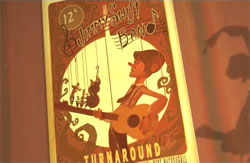 has been rapidly emerging as the hot Canadian animation studio. Working with John K on a music video never hurts your profile, and their new music video for The Jimmy Swift Band (MySpace) song Turnaround (off their new album Weight of the World) is due to get them even more notoriety.
has been rapidly emerging as the hot Canadian animation studio. Working with John K on a music video never hurts your profile, and their new music video for The Jimmy Swift Band (MySpace) song Turnaround (off their new album Weight of the World) is due to get them even more notoriety.
Bradley Cayford directed this Flash-animated video alongside the Copernicus team, and it holds water against any of the great music videos produced in recent memory.
Cold Hard Flash recently traded emails with Bradley and below is the elaborate result.
AARON SIMPSON: How did the concept for the video come about?
BRADLEY CAYFORD: To be honest with you, 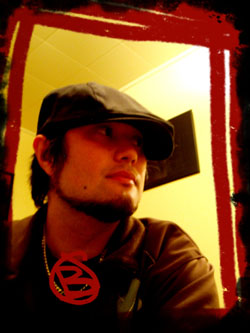 I just listened to the song and it really spoke to me. The original idea was more about The Great Depression and I had been watching documentaries at the time regarding that time period. The lyrics in the song and the vibe was mostly about a period in one’s life where there is a need to fight back, so I immediately thought of that time period. As time passed, new ideas came into play and it became more of a movement and a battle between the organic and technology in a sense. There were thoughts of putting in a lot of heida artwork as well and really making it a spiritual journey, but I felt that detracted from the story. Maybe if it was a 10 minute video then I could have really taken off with some of those ideas, but I think that I had to really condense everything just to make it more readable. It’s really difficult when you have a billion ideas of how you want to tell the story but you only have a few minutes to do so. I suppose that every time I erased some of the ideas, I had to stand back and reassess what the story supposed to be about in it’s most pure and simple form. Once I got that ball rolling, the creative fuels started to burn and it just took off.
I just listened to the song and it really spoke to me. The original idea was more about The Great Depression and I had been watching documentaries at the time regarding that time period. The lyrics in the song and the vibe was mostly about a period in one’s life where there is a need to fight back, so I immediately thought of that time period. As time passed, new ideas came into play and it became more of a movement and a battle between the organic and technology in a sense. There were thoughts of putting in a lot of heida artwork as well and really making it a spiritual journey, but I felt that detracted from the story. Maybe if it was a 10 minute video then I could have really taken off with some of those ideas, but I think that I had to really condense everything just to make it more readable. It’s really difficult when you have a billion ideas of how you want to tell the story but you only have a few minutes to do so. I suppose that every time I erased some of the ideas, I had to stand back and reassess what the story supposed to be about in it’s most pure and simple form. Once I got that ball rolling, the creative fuels started to burn and it just took off.
AARON: Where did you draw your inspiration from?
BRADLEY: It may appear that Pinocchio was the main source of inspiration, but that didn’t really happen until the later stages of the concept. I drew more inspiration from one of my favourite artists, Norman Rockwell. 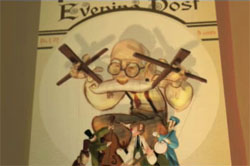 The way that he paints has such character to it and in the early stages of concept, I tried my best to capture something similar by presenting the band as hobos of the early 30′s. After that, my focus began to shift and I started to remember trips I took with my parents when I was a child and there were plenty of craft stores with sad clowns marionettes. I basically put the two together and out came the idea of marionettes.
The way that he paints has such character to it and in the early stages of concept, I tried my best to capture something similar by presenting the band as hobos of the early 30′s. After that, my focus began to shift and I started to remember trips I took with my parents when I was a child and there were plenty of craft stores with sad clowns marionettes. I basically put the two together and out came the idea of marionettes.
There’s always that period of time where you question your own ideas trying to make sense of them, but every time that particular thought came about, I just thought about texture, 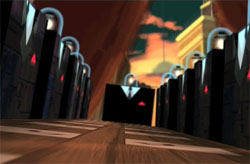 the colour and the odour of wood and I really wanted to bring that to life. I found this to be a solid foundation for the video but it was missing the sense of need. Who built this city in which the marionettes would go homeless in the first place? Then I had a dream that there were these really box-like robots with ties painted onto them. I like retro designs and it seemed really funny to me that there were these gigantic, obsolete robots patrolling the city. It’s like looking at old computers and how slow and big they are. The same idea applies to these robots. They’re not very smart (they have a lightbulb for a brain) but seem to enjoy their business attire. However, if you were to nudge them at any point, they’d surely fall down and wouldn’t be able to get up.
the colour and the odour of wood and I really wanted to bring that to life. I found this to be a solid foundation for the video but it was missing the sense of need. Who built this city in which the marionettes would go homeless in the first place? Then I had a dream that there were these really box-like robots with ties painted onto them. I like retro designs and it seemed really funny to me that there were these gigantic, obsolete robots patrolling the city. It’s like looking at old computers and how slow and big they are. The same idea applies to these robots. They’re not very smart (they have a lightbulb for a brain) but seem to enjoy their business attire. However, if you were to nudge them at any point, they’d surely fall down and wouldn’t be able to get up.
At first, I wanted the robots to look more like 20′s and 30′s automobiles, but I ended up settling down with the idea that they’d look better if they’re simple. I don’t know how many artists have done artwork like this, and it’s hard for me to point out one specific source as to where I drew my inspiration, but I think a large portion of it comes from naturally observing a lot of artwork and day-to-day things. 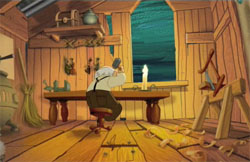 Norman Rockwell is probably my most influential artist though, but it goes without saying that I always run my ideas by and get a lot of brand new ideas from everyone here at Copernicus Studios. One of the biggest sources of inspiration is my good friend, Murray Bain. He always shares his thoughts on these ideas and the history book in his head often brings forth the small things that best illustrate the time period.
Norman Rockwell is probably my most influential artist though, but it goes without saying that I always run my ideas by and get a lot of brand new ideas from everyone here at Copernicus Studios. One of the biggest sources of inspiration is my good friend, Murray Bain. He always shares his thoughts on these ideas and the history book in his head often brings forth the small things that best illustrate the time period.
AARON: What was the band’s reaction to the concept?
BRADLEY: They liked the idea from day one. However, the idea changed multiple times throughout the production and I didn’t necessarily give all the details until I was sure about every step. 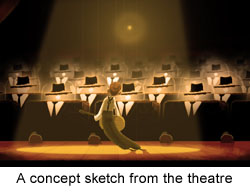 Typically, when I put a pitch package or proposal together, I know that the story is going to develop slowly and that it will be primarily driven by the artwork. I spend more time sketching my ideas rather than just simply writing them because I feel that colours and composition bring forth so much more emotion than words. From the very first sketch, I decided what colours I wanted to use and it really brought out the passion that I feel in their music. My drawings may not be that great and the ideas may be unfinished so there’s a lot of room for polish, but if you can capture the proper mood just through use of colour and tie that to the song, then I’m already walking down the right path… I think.
Typically, when I put a pitch package or proposal together, I know that the story is going to develop slowly and that it will be primarily driven by the artwork. I spend more time sketching my ideas rather than just simply writing them because I feel that colours and composition bring forth so much more emotion than words. From the very first sketch, I decided what colours I wanted to use and it really brought out the passion that I feel in their music. My drawings may not be that great and the ideas may be unfinished so there’s a lot of room for polish, but if you can capture the proper mood just through use of colour and tie that to the song, then I’m already walking down the right path… I think.
One of the first things the band said to me after seeing my initial drawings (and one of the last things that they said to me) was how much they enjoyed the colours of the video. When I listened to the song, those colours that you see in the video are the colours that I thought of the first time I listened to it. I think things like that are so important as a base because it’s the first thing you’ll notice on the screen. Colours have such a large effect on our emotions and I’m glad that they were happy with that. Some original ideas came from others – like having the band walking down the street singing the song and then whenever they say, “I think it’s time we turn around” then they turn around and notice all the people following them. It’s not a bad idea, but if I know that something is that obvious and has been done so many times, then it just makes me want to really search deep in my brain and in my dreams for some really wild idea that fits even more accurately and emotionally than that.
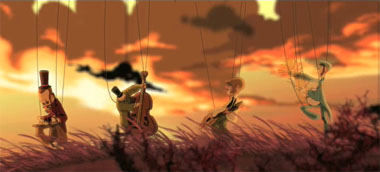
I’m a big fan of The Jimmy Swift Band. They put a lot of creative thought into their music and I think that if there is going to be a visual attached to their music it should at least come close to equalling their creativity. They liked the concept, start to finish, and supported it heavily as I support the music they play. It’s definitely great to work close with people who share that same drive.
AARON: Do you have any personal experience with marionettes?
BRADLEY: I suppose that I don’t really have any personal experience in that manner, but I experimented with stop motion when I was younger. My sister had a lot of dolls around and a dollhouse so for school projects sometimes I’d try to animate them. 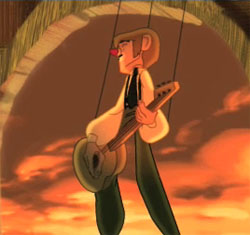 Marionettes always interested me, primarily from all the craft stores that my parents used to take me to. I was surrounded with an incredible variety of artwork and have seen shows with a wide variety of marionettes on stage. When I was younger, my family used to bring me to see things like Cirque Du Soleil, and, in my opinion, watching those entertainers is a lot like watching a very skilled puppet master with his marionettes. There is definitely something about the theatre that catches my eye.
Marionettes always interested me, primarily from all the craft stores that my parents used to take me to. I was surrounded with an incredible variety of artwork and have seen shows with a wide variety of marionettes on stage. When I was younger, my family used to bring me to see things like Cirque Du Soleil, and, in my opinion, watching those entertainers is a lot like watching a very skilled puppet master with his marionettes. There is definitely something about the theatre that catches my eye.
AARON: How long did the whole production take?
BRADLEY: Well, I spent most of the production working on the concept and storyboards. I wanted to make sure that everything was as clear as possible at every stage so that once we got to animation and post there would be no questions asked and nothing would have to be recalled. I’m a very ambitious person and sometimes it gets the best of me. 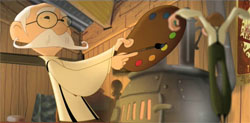 Having four main characters, the puppet master, the skydivers, background characters, execubots, execumilitary and execublimps is quite a large character design workload for a three-minute film. I really didn’t want to hold back though and we put forth a lot of effort into making sure that each one of those characters was handled very delicately.
Having four main characters, the puppet master, the skydivers, background characters, execubots, execumilitary and execublimps is quite a large character design workload for a three-minute film. I really didn’t want to hold back though and we put forth a lot of effort into making sure that each one of those characters was handled very delicately.
Murray Bain worked primarily on the Execubots, building them in After Effects, and you can see how much fun he had with them. The backgrounds were painted and I find that they turned out incredibly well. There were some very talented people gracing this video with their gifted hands. Justin Niewland, Ian Westoby, David Sourwine, Faith Hicks and I all had our hands on those backgrounds and Juan Cruz Baldassarre (CEO of Copernicus Studios) along with Murray Bain (Partner and Director of Copernicus Studios) added some love to those shots with their keen eyes and really enhanced the colours and depth of each of those shots. There was so much care at every level of this production. Videofact (Canadian funding company for musicians and music videos) and The Jimmy Swift Band were very kind to us and understood the type of product we were producing, so they were very patient with us from the beginning. I’m glad that I had everyone’s support on this and even though it took a few months, it was well worth it.
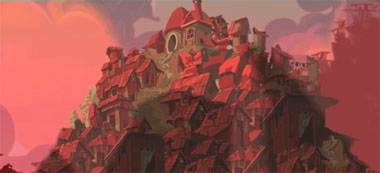
AARON: How big was the team?
BRADLEY: The talented team that I work with here at Copernicus has learned to do the best that they possibly can do with whatever you ask of them. By the end, there were roughly twelve or thirteen people working on the video. It really started out as with me doing character designs, storyboards, concept art as well as research work. My close friend Bianca Siercke started to help me out with cleaning up character designs and of course adding in her own flavour. 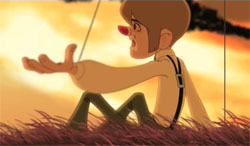 She is incredibly gifted and I couldn’t imagine a better scenario than working with someone as talented as she is. She later moved onto doing special effects and did some incredibly romatic and theatrical scenes in the video that will stand out in my head forever.
She is incredibly gifted and I couldn’t imagine a better scenario than working with someone as talented as she is. She later moved onto doing special effects and did some incredibly romatic and theatrical scenes in the video that will stand out in my head forever.
Here at Copernicus we really push the idea of animating classically. I’m still not sold on animating with a Wacom. It has it’s limits on the feeling that you get when you do a drawing. There is nothing like the grain on the paper. Considering this film is completely about that organic feel, I felt it best to key everything on paper. I then scanned everything and cleaned each pose out in Flash and handed some scenes out to others. I was then able to get some other friends here to showcase their skills. Joe Achorn, Mike Fiander, Dharmali Patel, Andrew Holland, Wes Bryant and Bianca Siercke took charge in that department. They produced some incredible inbetweening. Add in the incredible work of Ian Westoby, Justin Niewland, Murray Bain, Faith Hicks and David Sourwine on backgrounds with Murray doubling up on post production along side Juan Cruz Baldassarre and the art team who emerged as a dream team. President Paul Rigg handled key elements of the contract and was in tight contact with Videofact to make the process run all that much smoother. All-in-all, I’d say there was about twelve to thirteen people or so, but truly there are far more people that I went to as close friends for some support along the way.
AARON: What was the process like?
BRADLEY: I once worked with a man named, Aubry Mintz. He’s a fantastic teacher and taught me a lot about art in general in the little time that I worked with him a few years ago. 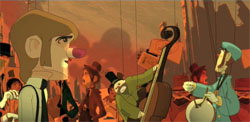 I was also lucky enough to work with Jeff Denovan as well at Big House animation along with Vasilios Papaganis and Sam Chow. I bring these people up because they encouraged me to feel emotionally attached to what I draw. When telling a story, I think that sketching your ideas down or painting them naturally is always the best option because it’s easier to read into the character that way. How hard you press down on the paper or how delicate your touch is can convey certain emotions in the viewer or at least help in that way. I drew everything first before bringing it into flash – even to the point of keying everything with paper. For some reason – and this likely differs from artist to artist – I can really feel the character out better if I sketch him singing or acting on paper rather than creating the character in Flash.
I was also lucky enough to work with Jeff Denovan as well at Big House animation along with Vasilios Papaganis and Sam Chow. I bring these people up because they encouraged me to feel emotionally attached to what I draw. When telling a story, I think that sketching your ideas down or painting them naturally is always the best option because it’s easier to read into the character that way. How hard you press down on the paper or how delicate your touch is can convey certain emotions in the viewer or at least help in that way. I drew everything first before bringing it into flash – even to the point of keying everything with paper. For some reason – and this likely differs from artist to artist – I can really feel the character out better if I sketch him singing or acting on paper rather than creating the character in Flash.
I honestly don’t believe that one should do all the stages in a program. If you can’t do it on paper, it’s not likely that you’ll be able to do a better job on the computer. Doing things on paper first brings out the most organic idea right from the beginning. 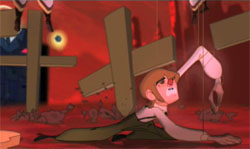 I find that a lot of people believe that the Wacom gives them a better line, but for those that don’t sketch on a regular basis, the Wacom is not going to save your skills. I’ve seen some great animation out of a lot of people that use Wacoms, but they all use it like it’s a pencil, not like a magic wand – and that’s why their animation looks good. The software is just your canvas, but your hands and ideas are what makes it work, not the computer or what is programmed into it. We try to use Flash for what it is and where we see it can be used to our advantage, but we are all classically trained here and I don’t really foresee that changing any time in the near future. Flash has enabled us to be efficient, but the second that it starts reducing our quality and jeopardizing the artwork we put it back to the paper, we’ll move on. Skill with your mind can never be taken away, so we never train one to think that they need the program to function, for they can function just fine without it. That being said, I do enjoy using Flash, but it usually isn’t until the final stages of production that we do.
I find that a lot of people believe that the Wacom gives them a better line, but for those that don’t sketch on a regular basis, the Wacom is not going to save your skills. I’ve seen some great animation out of a lot of people that use Wacoms, but they all use it like it’s a pencil, not like a magic wand – and that’s why their animation looks good. The software is just your canvas, but your hands and ideas are what makes it work, not the computer or what is programmed into it. We try to use Flash for what it is and where we see it can be used to our advantage, but we are all classically trained here and I don’t really foresee that changing any time in the near future. Flash has enabled us to be efficient, but the second that it starts reducing our quality and jeopardizing the artwork we put it back to the paper, we’ll move on. Skill with your mind can never be taken away, so we never train one to think that they need the program to function, for they can function just fine without it. That being said, I do enjoy using Flash, but it usually isn’t until the final stages of production that we do.
AARON: Did you composite any 3D elements into the video?
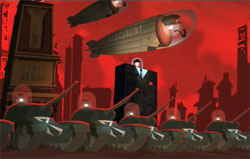
BRADLEY: There was no real 3D in the video. Most elements were designed very flat to begin with and brought into After Effects where we assembled a 3D space with cameras and wonderful lighting. All the backgrounds were painted and all the characters were flat with proper layering to give the effect of 3D space. I suppose that the closest thing to 3D were the Execubots. Murray Bain built them in After Effects using some textures that he made up in Photoshop.
The special effects were a mix of After Effects, Flash and classical animation such as grass, bushes, leaves, explosions and whatnot. All of the camera moves were done in After Effects with characters carefully staged to give the perception of depth. I studied a lot of old photographs where the focus is so incredibly deep. Most photographs gave the illusion that background elements were a lot further back than they actually were and to me it suggested that there was such a vast area of space and it made the characters appear even smaller. I tried to suggest that as well in this video so that it would make the marionettes seem even more vulnerable to their surroundings.
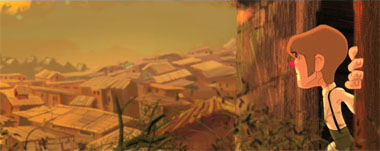
AARON: Was there a shot that proved most difficult?
BRADLEY: The smokestack sequence was one I imagined would have been difficult, but it ended up being a lot easier, animation-wise. The post production of that beginning of that scene was a little more difficult – where there’s the pullout from the crowd leading into the propaganda type of visual. Speaking for the post production crew, the crowd scene was likely the most difficult of all. Most of the scenes with the Execubots were very difficult as well like making them all fall to the ground or having them drive around a little bit, but I think you can tell that Murray Bain had a lot of fun amidst all the stress working on those scenes and I think they really stand out.
Strictly from an animation standpoint, I’d have to say that the most difficult scenes that I worked on were any of the four character scenes where the band is just jamming. 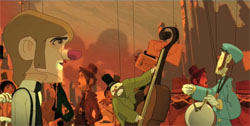 It was very difficult to really capture their character but also try and make them fit into the time period and scenes appropriately. I like the scene where they all drop from the sky. I think I can speak for everyone in saying that we’re all proud of it and no matter how difficult it was, the reward is right in front of our faces.
It was very difficult to really capture their character but also try and make them fit into the time period and scenes appropriately. I like the scene where they all drop from the sky. I think I can speak for everyone in saying that we’re all proud of it and no matter how difficult it was, the reward is right in front of our faces.
AARON: How did you do the golden silhouette transitions?
BRADLEY: You know, that was one of the first scenes I worked on without really knowing what the result would be. Originally, I had planned that sequence to be more green and rusty colours to match some of the propaganda research I had done. I neglected that scene for quite some time and found that it stood out and didn’t flow with the rest of the video, so I revised it and put in some things that I had animated for fun for the band. I think it turned out to be a cool sequence with some nice flatness to it.
One thing that I noticed in propaganda art is that it’s generally graphically flat. I really love artwork that’s simple like that. Even in Norman Rockwell art there are these incredibly detailed characters but then just a circle in the background or something like that. 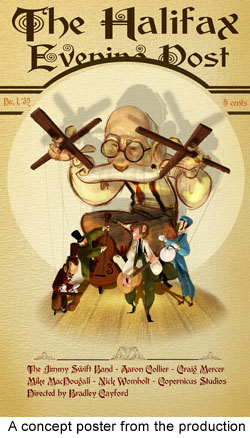 Negative space and simple shapes are amazing sometimes. I decided to make it look as simple as possible with hints of texture so you can see them really clashing against eatchother. The idea of the smokestacks came from a piece of Russian constructivism that was also used as a Futurama poster. I found it pretty interesting and I wanted to do my take on it, but I worked my way off the idea as an inspiration, rather than using it as a parody or completely suggestive as to the original meaning of that artwork. It really didn’t look anything like the that Russian constructivism painting, but rather had it’s own look which I prefer. Most of that scene was animated quickly in Flash with some added painted textures. Then we added some flare to it with a touch of lighting and a glow in After Effects. It was carefully thought out though long before I started animating anything else, but in a very experimental way. I just went with the flow of the music and one-timed it, essentially.
Negative space and simple shapes are amazing sometimes. I decided to make it look as simple as possible with hints of texture so you can see them really clashing against eatchother. The idea of the smokestacks came from a piece of Russian constructivism that was also used as a Futurama poster. I found it pretty interesting and I wanted to do my take on it, but I worked my way off the idea as an inspiration, rather than using it as a parody or completely suggestive as to the original meaning of that artwork. It really didn’t look anything like the that Russian constructivism painting, but rather had it’s own look which I prefer. Most of that scene was animated quickly in Flash with some added painted textures. Then we added some flare to it with a touch of lighting and a glow in After Effects. It was carefully thought out though long before I started animating anything else, but in a very experimental way. I just went with the flow of the music and one-timed it, essentially.
AARON: What was the band’s reaction when they saw the finished piece?
BRADLEY: The band really liked the video. They support our work as we support theirs. I met their keyboard artist, Aaron Collier, a few years ago on our way to the East Coast Music Awards. I believe that The Jimmy Swift Band had a bunch of shows over the weekend and I was heading down there because my first music video, “Universal Soul’s – Way Back In The Day” (a solo project that I did out of the corner of my bedroom) was nominated for a few video awards. Aaron brought up the idea that we do some work together. A few years passed and we finally came up with the notion to do a music video together. You’d figure that we would’ve thought of that back then, but for some reason it slipped our minds and we were talking more about doing film scores. I’m a big fan of theirs so I signed onto this idea immediately.
Universal Soul – Way Back In The Day
We both worked really hard on our respective parts of the video and when it came out I think both the band and I breathed a collective sigh of relief – and then we raised our tequila shots to the sky and drank one in celebration. We’re all happy with the outcome of the video and I think they plan to use it on their upcoming tour to help advertise. They already have a big following and I think they know it’s just about to get that much bigger now. I wanted to do some artwork that could potentially help them and now knowing that they’re happy with it makes it all the worthwhile to me.
AARON: When did you first pick up Flash?
BRADLEY: I fist picked up Flash back in 2001. I was working for a small company out here in Halifax for about a year. We were mostly doing web films and I was lucky enough to get some good ol’ fashioned on-the-job-training in Flash. 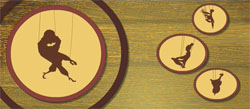 Well, it was more like being thrown to the dogs. It’s a good thing that Flash is really easy to pick up and I always knew that if I applied my classical abilities to it that the sky was the limit.
Well, it was more like being thrown to the dogs. It’s a good thing that Flash is really easy to pick up and I always knew that if I applied my classical abilities to it that the sky was the limit.
When the company shut down and we were without paycheques, our severance became our work computers. Without food or rent, I still had a Pentium 2 to live off of. I took it back home to my parents place in Pickering, Ontario, made a few calls and got myself a music video. It was the very first time that I worked independently on something and it was also my first music video. 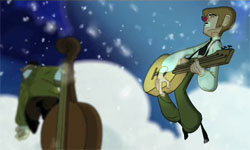 Most of the work was done classically and honestly, I felt much more comfortable doing things that way. The music video went to Muchmusic and was widely accepted. I couldn’t believe that it was nominated for a few awards later that year and most people didn’t believe that it was animated using Flash. Talk about making the best out of a bad situation!
Most of the work was done classically and honestly, I felt much more comfortable doing things that way. The music video went to Muchmusic and was widely accepted. I couldn’t believe that it was nominated for a few awards later that year and most people didn’t believe that it was animated using Flash. Talk about making the best out of a bad situation!
As it turns out, I still use Flash quite a bit, but I treat it with respect and use it for where I feel it can help. I look back at the video and realize that the animation isn’t that great, but I still love the ideas that were expressed, both in the song and also in the visuals. The name of the group is Universal Soul and the song is called, “Way Back In The Day” and I truly have to thank those guys for getting me started. One of my Flash mentors is my good friend, Murray Bain. He has taught me a lot about how to use the program to it’s fullest along with helping me experiment with what we can do in After Effects and beyond. Whenever I had a question regarding Flash, he answered it all and I’m very grateful for that.
AARON: How much re-use is in this piece?
BRADLEY: There was a fair amount of reuse and I think that it was used wisely. When doing music videos, I believe repetition is important so the viewer can be reminded about certain aspects of the video and identify with them. I wanted some of the characters to have similar actions throughout so that they remain looking like puppets throughout and this would be the characterization of a puppet in my mind. They do pretty much the same thing show-to-show in puppetland so why not make this video look like it’s actually a show to the viewer as well? In many ways I find it comical how each of those characters are portrayed. They all seem to be very fun and I just kept on wanting to show that throughout. When it came to the backgrounds, we reused bits and pieces here and there which is very common in animation. It’s there to identify where the characters are coming from and where they are staged.
I also wanted to show what they represent as well. 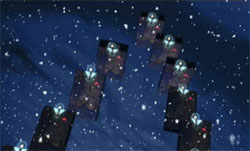 Execubots and city on the left, shanty town and marionettes on the right. Pieces got reused here and there because it keeps it very simple and I found it a very efficient way to work. I think there are just hints of reuse in this piece and where it was necessary we went all-out with some acting and strong posing when we could really explore that deeply.
Execubots and city on the left, shanty town and marionettes on the right. Pieces got reused here and there because it keeps it very simple and I found it a very efficient way to work. I think there are just hints of reuse in this piece and where it was necessary we went all-out with some acting and strong posing when we could really explore that deeply.
AARON: What’s the secret to creating an award-winning music video?
BRADLEY: Honestly, I don’t know that there are any secrets that I hold. I’ve been very fortunate to be able to do these music videos and extra fortunate that people look at them and like them enough to nominate them for awards. That being said, I’ve never done any of these music videos so that they will win any awards. It’s more about just listening to the music, giving it some visuals that I see when I listen to the song and making sure it’s in the best interest of everyone involved. I really want both the band and Copernicus Studios to push forward and if I can help both of them, then that’s my main goal.
I think that as long as people are honest with what they put on the screen then you can easily make a good video. I’m tired of just seeing girls and cars and money on the screen because these videos last about 5 minutes in my head, then I forget about them. I think it stands out in my head more if someone gives some meaning to it emotionally. It’s the same with movies. Action flicks have a short life, but when you sit there and watch films that you can feel involved in, it has a much deeper and longer lasting impact on the audience.
Everyone has cool dreams and everyone has cool ideas, 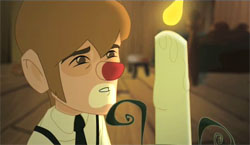 and it’s just a matter of sitting down, thinking it though and just feeling it out from every angle. Think it through and sketch it out without any fear. Truly, is anyone going to stop you? The only person that stops anyone is themselves, and I’m not about to let that happen to myself. I know I’m not the best, nor do I care if anyone sees me as the best or worst or anything. I think that the one thing that keeps me going is simply that I just really badly want to keep trying to tell stories and work with great people along the way. It’s helped me carve a new path from day to day and there are truly no regrets. I suggest to everyone that they just put forth their best ideas and there’s always gold at the end of that path.
and it’s just a matter of sitting down, thinking it though and just feeling it out from every angle. Think it through and sketch it out without any fear. Truly, is anyone going to stop you? The only person that stops anyone is themselves, and I’m not about to let that happen to myself. I know I’m not the best, nor do I care if anyone sees me as the best or worst or anything. I think that the one thing that keeps me going is simply that I just really badly want to keep trying to tell stories and work with great people along the way. It’s helped me carve a new path from day to day and there are truly no regrets. I suggest to everyone that they just put forth their best ideas and there’s always gold at the end of that path.
AARON: Do you play any musical instruments?
BRADLEY: I couldn’t imagine what my life would’ve been like if I didn’t play musical instruments. 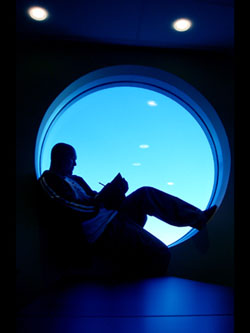 I enjoy music way too much nowadays to let that kind of thing escape me. Of course I’m terrible at most instruments, but I love to fiddle around every now and then with the piano and djembe. I took piano, like many kids, for many years when I was young. Once I got into high school, I played tenor saxophone in the band for a year as well. From that point on I flipped over to fine arts and just had music surrounding me on the side, but never directly in my hands anymore. I guess there was the odd harmonica lying around and now my djembe, but I relied more on the music artists that I grew up with that were very good friends of mine. My friend, Jasper, is a world class DJ who is like a brother to me so I was completely surrounded with great music at all time. At work I often listen to all genres of music and so it sort of takes the place of playing instruments in some manner because I can still extract the essential pieces of it. I feel like I really understand the meaning to music which is very essential as a director to creating films.
I enjoy music way too much nowadays to let that kind of thing escape me. Of course I’m terrible at most instruments, but I love to fiddle around every now and then with the piano and djembe. I took piano, like many kids, for many years when I was young. Once I got into high school, I played tenor saxophone in the band for a year as well. From that point on I flipped over to fine arts and just had music surrounding me on the side, but never directly in my hands anymore. I guess there was the odd harmonica lying around and now my djembe, but I relied more on the music artists that I grew up with that were very good friends of mine. My friend, Jasper, is a world class DJ who is like a brother to me so I was completely surrounded with great music at all time. At work I often listen to all genres of music and so it sort of takes the place of playing instruments in some manner because I can still extract the essential pieces of it. I feel like I really understand the meaning to music which is very essential as a director to creating films.
AARON: What project is up next?
BRADLEY: I’m working on a few projects at the moment. 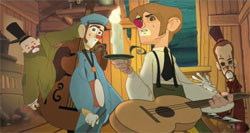 In the future, I’d love to keep on doing music videos and also working with good friends and good people. Just want to add to the family. I’d love to create some feature films that have a lot of meaning too and I’m trying to give myself some proper training to do those things by creating these music videos.
In the future, I’d love to keep on doing music videos and also working with good friends and good people. Just want to add to the family. I’d love to create some feature films that have a lot of meaning too and I’m trying to give myself some proper training to do those things by creating these music videos.
AARON: What’s on your holiday gift list?
BRADLEY: I never really ask for anything this time of year. Socks and underwear are the standard. To be honest, I just want things to keep moving. I hope that everyone stays safe and everyone close to me has a great year ahead of them. I’m just happy to be working with very talented people here at Copernicus and I’m very lucky to have a very supportive family and friends on my side. I hope that for Christmas I can get more friends on top of that and make their world a better place if I can. Merry Christmas and Happly Holidays everyone!











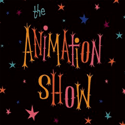
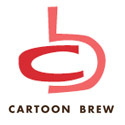

December 15th, 2006 at 8:04 pm
That’s just plain gorgeous work in every way! Hello Halifax!
- Scotty A
December 15th, 2006 at 10:47 pm
Your studio is amazing! Keep up the great work!
Brendan,
Six Point Harness
December 15th, 2006 at 11:10 pm
Oh my good !! That’s incredible !!
December 15th, 2006 at 11:12 pm
that is amazing.
December 15th, 2006 at 11:51 pm
Great Work Brad!
Keep them pumpin!
Hurry up and do a feature!
December 16th, 2006 at 1:21 am
Everyone in the studio here loves this music video. Really inspirational. The illustration work is beautiful.
Michael
December 16th, 2006 at 10:31 pm
Thanks for the great interview- really inspirational and makes me want to work that much harder towards creating beauty.
Made me fantasize for a moment about moving to Halifax!
Paul
WilWhimsey.com
December 17th, 2006 at 3:12 am
Thanks Aaron for posting this up. It really means a lot to me. I’ll pass word on to the band that you guys are feeling this video. It was really a pleasure to work with everyone on this project and it kept me highly inspired throughout knowing that there are a lot of talented people here too and I’m working for a talented band too. Thank you for the compliments. I’m just trying to make my way through…good to hear these very positive things from time to time…definitely keeps the chin up. Thanks again!
December 19th, 2006 at 12:39 pm
You guys video is just incredible! I just can’t imagine how you guys done
it on Flash! It’s very inspirational, it motivated me to work even harder. Can anyone of you lend me some tips on production techniques in creating
animation in flash for broadcast or for the web. I am an aspring Flash
Artist/Animator and it’ll be great if any of you guys can start me off and help me improve in what I’m doing! Please send me an email at ce_nofx@hotmail.com. Thanx! More power to you!
December 20th, 2006 at 7:06 pm
Simply Stunning Work Copernicus!!
You guys are tops!
November 27th, 2009 at 3:32 am
[...] There must be something connected to puppets in the water at animation studios in Halifax lately. I blogged about The Wippets just a little while ago (see previous post) and now Halifax’s Copernicus Studios has just finished an unbelievably good puppetry-inspired music video for the The Jimmy Smith Band called Turnaround. It’s one of the best animated videos I’ve seen in quite awhile so be sure to take a look. You can also read an interview about it with director Bradley Cayford over at Cold, Hard Flash. [...]